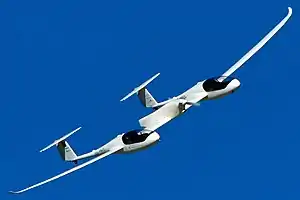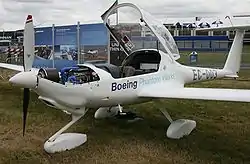Hydrogen-powered aircraft
A hydrogen aircraft is an aeroplane that uses hydrogen fuel as a power source. Hydrogen can either be burned in a jet engine, or other kind of internal combustion engine, or can be used to power a fuel cell to generate electricity to power a propeller.
Unlike most aircraft, which use wings for storing fuel, hydrogen aircraft are usually designed with the hydrogen fuel tanks carried inside the fuselage.
According to research at the Pennsylvania State University in 2006, large commercial hydrogen aircraft could be built by 2020 but "will probably not enter service until closer to 2040."[2] In the nearer term, interest has grown in using fuel cell aircraft as personal air vehicles.
The European Union's research project in cooperation with Airbus and 34 other partner companies dubbed CRYOPLANE assessed the technical feasibility, safety, environmental compatibility and economic viability of using liquid hydrogen as an aviation fuel. This was concluded in 2002 (with the final report published in 2003).[3]
Properties of hydrogen

Hydrogen has an specific energy that is 3 times higher than traditional jet fuel, but a lower energy density. In aircraft carbon fiber tanks are used, which can sustain a pressure of 700 bar. Cryogenic liquid hydrogen is also used.
If hydrogen is available in quantity from low-carbon energy sources such as wind or nuclear, its use in aircraft will produce fewer greenhouse gases (water vapor and a small amount of nitrogen oxide) than current aircraft. Currently very little hydrogen is produced using low-carbon energy sources, and there are several serious obstacles to the use of hydrogen in aircraft and other vehicles.[4] Due to the way it is produced, and the relative inefficiencies of its production given current technology, hydrogen is more expensive than fossil fuels.
Liquid hydrogen is one of the best coolants used in engineering, and it has been proposed to use this property for cooling intake air for very high speed aircraft (see precooled jet engine), or even for cooling the aircraft's skin itself, particularly for scramjet-powered aircraft.[5]
Design considerations
Liquid hydrogen has about four times the volume for the same amount of energy of kerosene based jet-fuel. In addition, its highly volatile nature precludes storing the fuel in the wings, as with conventional transport aircraft. Therefore, most liquid hydrogen aircraft designs store the fuel in the fuselage, leading to a larger fuselage length and diameter than a conventional kerosene fuelled aircraft. This lowers the performance due to the extra wetted area of the fuselage. The larger fuselage size causes more skin friction drag and wave drag. On the other hand, hydrogen is about one-third of the weight of kerosene jet-fuel for the same amount of energy. This means that for the same range and performance (ignoring the effect of volume), the hydrogen aircraft would have about one-third of the fuel weight. For a Boeing 747-400 type aircraft, this would reduce the takeoff gross weight from 360,000 to 270,000 kg (800,000 to 600,000 lb). Thus, the performance of a hydrogen-fueled aircraft is a trade-off of the larger wetted area and lower fuel weight. This trade-off depends essentially on the size of the aircraft.
History
.jpg.webp)
In February 1957, a Martin B-57B of the NACA flew on hydrogen for 20 min for one of its two Wright J65 engines rather than jet fuel.[6] On 15 April 1988, the Tu-155 first flew as the first hydrogen-powered experimental aircraft,[7] an adapted Tu-154 airliner.
Boeing converted a 2-seat Diamond DA20 to run on a fuel cell.[8] It first flew on April 3, 2008.[9] The Antares DLR-H2 is a hydrogen-powered aeroplane from Lange Aviation and the German aerospace center.[10] In July 2010, Boeing unveiled its hydrogen powered Phantom Eye UAV, that uses two converted Ford Motor Company piston engines.[11]
In 2010, the Rapid 200FC concluded six flight tests fueled by gaseous hydrogen. The aircraft and the electric and energy system was developed within the European Union's ENFICA-FC project coordinated by the Politecnico di Torino.[12] Hydrogen gas is stored at 350 bar, feeding a 20 kW (27 hp) fuel cell powering a 40 kW (54 hp) electric motor along a 20 kW (27 hp) lithium polymer battery pack.
On January 11, 2011, an AeroVironment Global Observer unmanned aircraft completed its first flight powered by a hydrogen-fueled propulsion system.[13]

Developed by Germany’s DLR Institute of Engineering Thermodynamics, the DLR HY4 four-seater was powered by a hydrogen fuel cell, its first flight took place on September 29, 2016.[14] It has the possibility to store 9 kg (20 lb) of hydrogen, 4x11 kW fuel cells and 2x10 kWh batteries.[15]
Proposed aircraft
Historical
- Lockheed CL-400 Suntan 1950's concept liquid hydrogen aircraft that was dropped in favour of the SR-71
- Liquid hydrogen was proposed for use on the scramjet-based National Aerospace Plane.
- AeroVironment Global Observer
Current
- Reaction Engines Skylon orbital hydrogen fuelled jet plane
- Reaction Engines A2 antipodal hypersonic jet airliner
- DLR Smartfish
- Boeing Phantom Eye
- The Greenliner (TU Delft)[16]
- The Cryo-V [17]
- ZeroAviaHyFlyer (fuel-cell)[18]
In September 2020, Airbus announced plans for three different hydrogen-fuelled concepts, collectively known as ZEROe, with the aim of developing zero-emission aircraft that could enter commercial service by 2035.[19] The aircraft are powered using hydrogen internal combustion (gas turbine) rather than hydrogen fuel cells.[20]
References
- Robertson, David (2008-04-03). "Boeing tests first hydrogen powered plane". The Times. London.
- Maniaci, David C. "Operational Performance Prediction of a Hydrogen-Fueled Commercial Transport" 2006 symposium paper Archived 2006-09-05 at the Wayback Machine
- Airbus Deutschland "Liquid Hydrogen Fuelled Aircraft - CRYOPLANE Final Technical Report" 2003
- "Hydrogen aircraft". H2 Vehicles. Archived from the original on 2012-06-18. Retrieved 2016-05-06.
- Segal, Corin (2010). The Scramjet Engine Processes and Characteristics. Cambridge University Press. p. 4. doi:10.1017/CBO9780511627019. ISBN 9780511627019.
- Guy Norris (October 1, 2020). "Will Contrails Be Hydrogen Fuel's Achilles' Heel?". Aviation Week.
- Dieter Scholz, Hamburg University of Applied Sciences (19 November 2020). "Design of Hydrogen Passenger Aircraft" (PDF).
- "Boeing Prepares Fuel Cell Demonstrator Airplane for Ground and Flight Testing" (Press release). Boeing. March 27, 2007.
- "Boeing Flies First Fuel Cell-Powered Airplane" (Press release). Boeing. April 3, 2008.
- "DLR motor glider Antares takes off in Hamburg – powered by a fuel cell" (PDF) (Press release). DLR. 7 July 2009.
- "Boeing Unveils Unmanned Phantom Eye Demonstrator" (Press release). Boeing. July 12, 2010.
- "ENFICA-FC".
- "Global Observer, AeroVironment's Extreme Endurance Unmanned Aircraft System, Achieves Historic First Hydrogen-Powered Flight" (Press release). AeroVironment. Jan 11, 2011.
- "Fuel cell aircraft HY4 makes maiden flight". The Engineer. 30 September 2016.
- "Vil ha kortdistanse flytrafikk over på hydrogen" (in Norwegian). Teknisk Ukeblad. 21 June 2017.
- ""The Greenliner", Green Flying Final Report DSE Group 8". Researhgate. Retrieved 31 July 2020.
- The Cryo-V Final DSE Report, June 30, 2020
- ZeroAvia Conducts UK's First Commercial-Scale Electric Flight, June 23, 2020
- "Airbus reveals new zero-emission concept aircraft" (Press release). Airbus. 21 September 2020.
- Tidey, Alice (21 September 2020). "Airbus unveils concepts for zero-emission planes powered by hydrogen". euronews.
External links
- Bjorn Fehrm (February 7, 2020). "Bjorn's Corner: Why e in ePlane shall stand for environment, Part 8". Leeham News.
- Dan Thisdell (9 July 2020). "Forget batteries, is hydrogen the holy grail for carbon-free commercial aviation?". Flightglobal.
